Community Assessment Report: 3804NRS, Trimester 1, Inala Community
VerifiedAdded on 2020/06/06
|9
|2930
|125
Report
AI Summary
This report presents a community assessment of Inala, addressing the purpose and concept of community assessment, key characteristics of the Inala community, and the social determinants of health impacting its residents. It identifies a vulnerable subgroup and discusses community needs assessment strategies, highlighting the importance of community engagement to explore health issues and unmet needs. The assignment analyzes the historical context, demographics, and cultural aspects of Inala, emphasizing factors such as language diversity, employment, and access to healthcare. The report also explores how these factors contribute to health disparities and outlines potential interventions to improve community health outcomes. The report emphasizes the need for a community needs assessment to identify and address the health-related challenges faced by the community, including issues related to disability, mental health, and access to healthcare services. The report concludes with a discussion of the importance of providing proper care and training to nurses and other healthcare professionals to effectively address the needs of the Inala community.

Community Nursing Practice
Paraphrase This Document
Need a fresh take? Get an instant paraphrase of this document with our AI Paraphraser
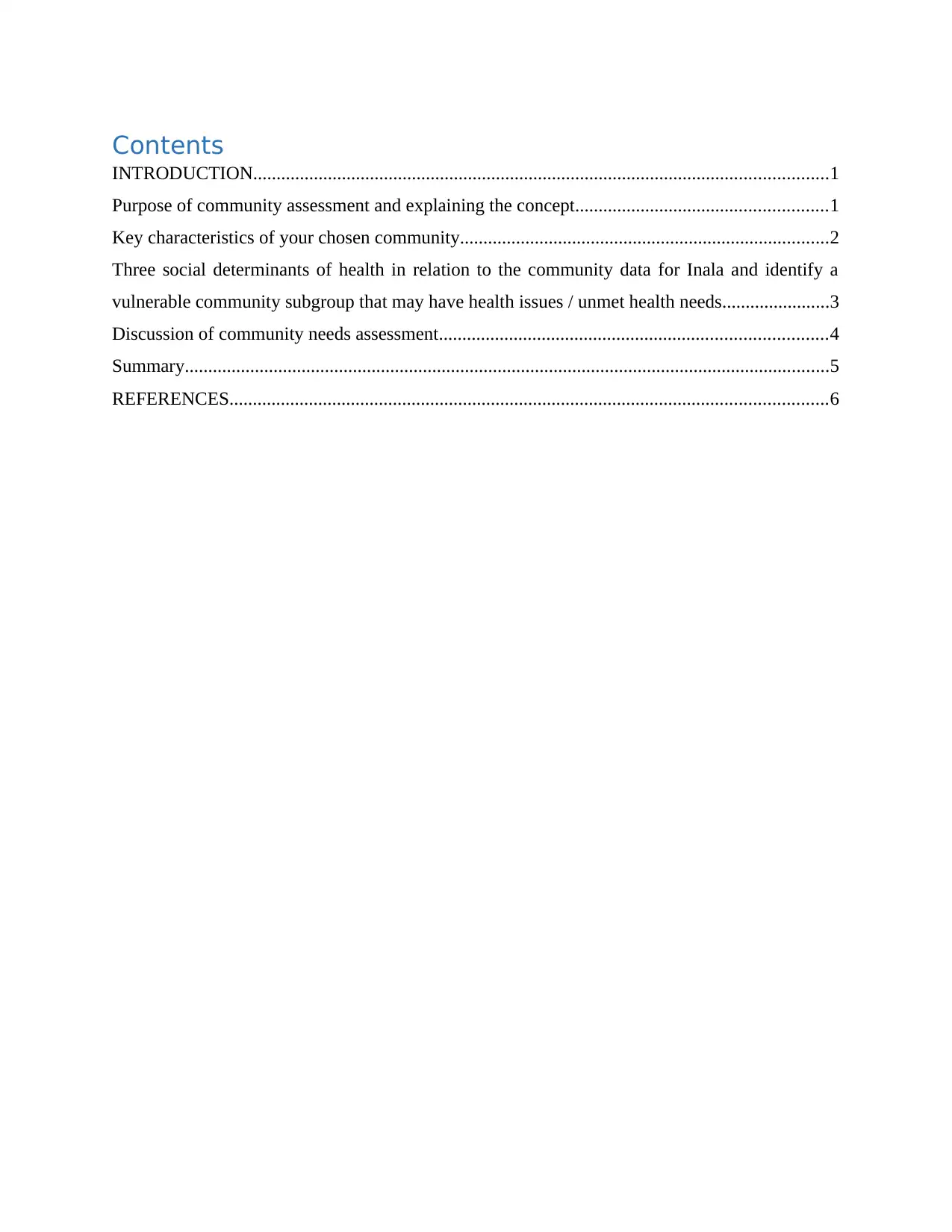
Contents
INTRODUCTION...........................................................................................................................1
Purpose of community assessment and explaining the concept......................................................1
Key characteristics of your chosen community...............................................................................2
Three social determinants of health in relation to the community data for Inala and identify a
vulnerable community subgroup that may have health issues / unmet health needs.......................3
Discussion of community needs assessment...................................................................................4
Summary..........................................................................................................................................5
REFERENCES................................................................................................................................6
INTRODUCTION...........................................................................................................................1
Purpose of community assessment and explaining the concept......................................................1
Key characteristics of your chosen community...............................................................................2
Three social determinants of health in relation to the community data for Inala and identify a
vulnerable community subgroup that may have health issues / unmet health needs.......................3
Discussion of community needs assessment...................................................................................4
Summary..........................................................................................................................................5
REFERENCES................................................................................................................................6

INTRODUCTION
With change in time, there are many health related issues that are faced by people
(DiGiacomo, Abbott and Davidson, 2010). In this context, healthcare professional are
responsible to make sure that appropriate steps are taken so that the problems that are faced by
them can be solved in effective manner (Durey, Thompson and Wood, 2012). In this present
assignment, Inala is taken as the chosen community (Askew, Jackson and Russell, 2010). This
covers purpose of community assessment and concept that is undertaken in reference with
scholarly literature. Lastly, it also includes discussion of community need that is assessment that
would engage with the identified vulnerable community subgroup to explore their health issues.
Main research thesis is that it enables to focus undertaking community assessment enables to
focus on controlling health related issues in effective manner.
Purpose of community assessment and explaining the concept
Community assessment can be determined as the process that enables to identify the
strengths, challenges, assets and needs of specified community (Jeremy, Tonkin and Kritharides,
2010). In this context, assets refer to the talents, abilities and skills of individuals and the
resources which local institutions that contribute to the community (Wilson, Magarey and Kelly,
2015). Further, local institution includes religious, political, youth organizations, recreational,
educational, etc. (Oliver, Rochecouste and Exell, 2013). There are various aspects that are
considered by community assessment. It includes evaluation of current situation of the
community, providing judgement of desired and preferred situation and making comparison of
desired and actual situation (Anikeeva, Katterl and Bywood, 2012).
Apart from this, there are different types of purpose with the help of community
assessment (Adams, 2010). It enables to mobilize community to take up appropriate actions so
that determined skills that can be used in the community to grow (Davy, Cass and Liu, 2016).
Further, enables to develop or create coalition action plan in which steps by steps strategies that
are to be applied are determined (Jackson, Tsai and Russell, 2010). When a goal is developed,
then it requires to develop appropriate objectives so that ultimate goal can be achieved (Isaacs,
Pyett and Waples‐Crowe, 2010). Moreover, various types of strategies need to be implemented
so that the goals and objectives that are to achieved can be direct in appropriate manner (Dart,
Jackson and Wilkinson, 2010). It enables to establish a base line with the help of which
evaluation of progress in the community (Oliver, Rochecouste and Exell, 2013). Further, it
1
With change in time, there are many health related issues that are faced by people
(DiGiacomo, Abbott and Davidson, 2010). In this context, healthcare professional are
responsible to make sure that appropriate steps are taken so that the problems that are faced by
them can be solved in effective manner (Durey, Thompson and Wood, 2012). In this present
assignment, Inala is taken as the chosen community (Askew, Jackson and Russell, 2010). This
covers purpose of community assessment and concept that is undertaken in reference with
scholarly literature. Lastly, it also includes discussion of community need that is assessment that
would engage with the identified vulnerable community subgroup to explore their health issues.
Main research thesis is that it enables to focus undertaking community assessment enables to
focus on controlling health related issues in effective manner.
Purpose of community assessment and explaining the concept
Community assessment can be determined as the process that enables to identify the
strengths, challenges, assets and needs of specified community (Jeremy, Tonkin and Kritharides,
2010). In this context, assets refer to the talents, abilities and skills of individuals and the
resources which local institutions that contribute to the community (Wilson, Magarey and Kelly,
2015). Further, local institution includes religious, political, youth organizations, recreational,
educational, etc. (Oliver, Rochecouste and Exell, 2013). There are various aspects that are
considered by community assessment. It includes evaluation of current situation of the
community, providing judgement of desired and preferred situation and making comparison of
desired and actual situation (Anikeeva, Katterl and Bywood, 2012).
Apart from this, there are different types of purpose with the help of community
assessment (Adams, 2010). It enables to mobilize community to take up appropriate actions so
that determined skills that can be used in the community to grow (Davy, Cass and Liu, 2016).
Further, enables to develop or create coalition action plan in which steps by steps strategies that
are to be applied are determined (Jackson, Tsai and Russell, 2010). When a goal is developed,
then it requires to develop appropriate objectives so that ultimate goal can be achieved (Isaacs,
Pyett and Waples‐Crowe, 2010). Moreover, various types of strategies need to be implemented
so that the goals and objectives that are to achieved can be direct in appropriate manner (Dart,
Jackson and Wilkinson, 2010). It enables to establish a base line with the help of which
evaluation of progress in the community (Oliver, Rochecouste and Exell, 2013). Further, it
1
⊘ This is a preview!⊘
Do you want full access?
Subscribe today to unlock all pages.

Trusted by 1+ million students worldwide
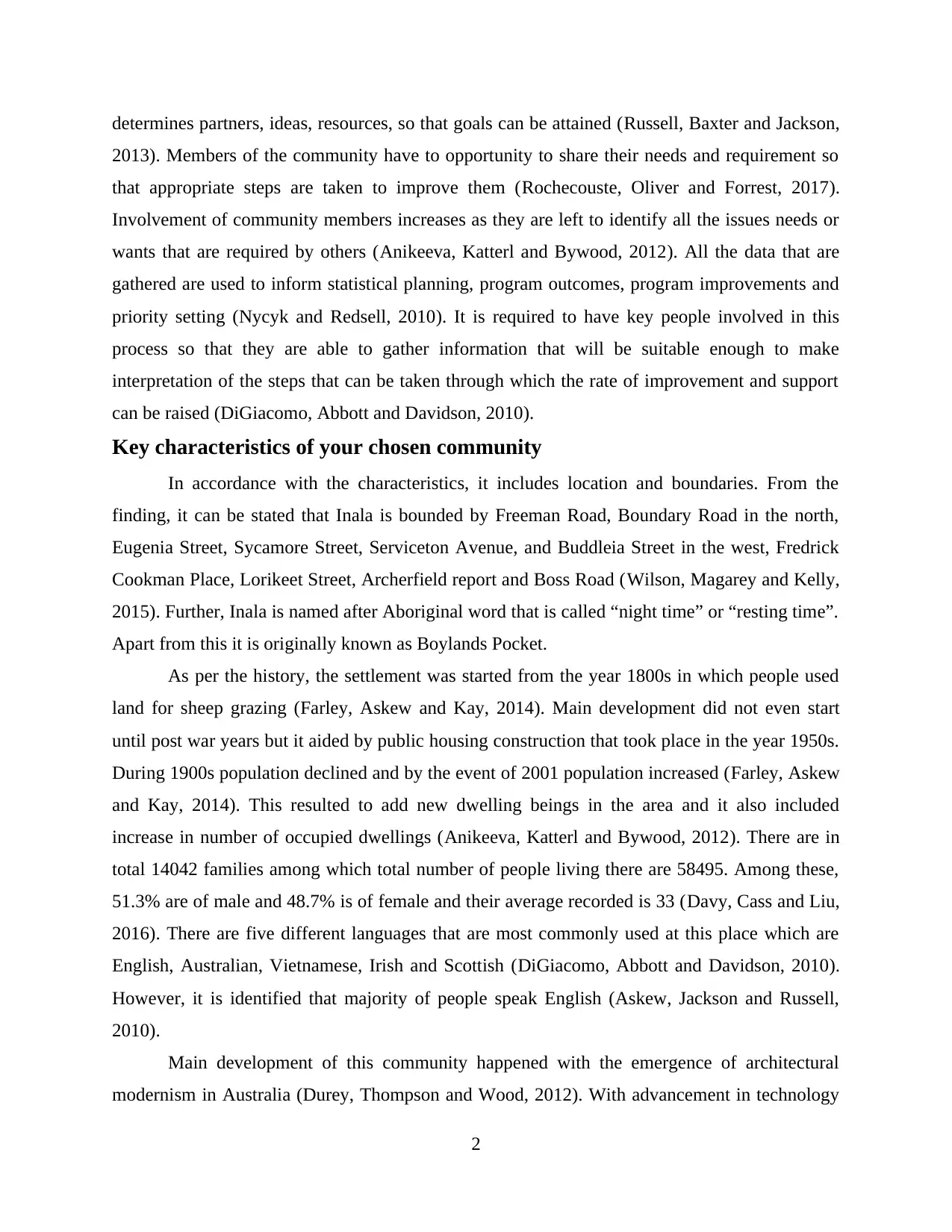
determines partners, ideas, resources, so that goals can be attained (Russell, Baxter and Jackson,
2013). Members of the community have to opportunity to share their needs and requirement so
that appropriate steps are taken to improve them (Rochecouste, Oliver and Forrest, 2017).
Involvement of community members increases as they are left to identify all the issues needs or
wants that are required by others (Anikeeva, Katterl and Bywood, 2012). All the data that are
gathered are used to inform statistical planning, program outcomes, program improvements and
priority setting (Nycyk and Redsell, 2010). It is required to have key people involved in this
process so that they are able to gather information that will be suitable enough to make
interpretation of the steps that can be taken through which the rate of improvement and support
can be raised (DiGiacomo, Abbott and Davidson, 2010).
Key characteristics of your chosen community
In accordance with the characteristics, it includes location and boundaries. From the
finding, it can be stated that Inala is bounded by Freeman Road, Boundary Road in the north,
Eugenia Street, Sycamore Street, Serviceton Avenue, and Buddleia Street in the west, Fredrick
Cookman Place, Lorikeet Street, Archerfield report and Boss Road (Wilson, Magarey and Kelly,
2015). Further, Inala is named after Aboriginal word that is called “night time” or “resting time”.
Apart from this it is originally known as Boylands Pocket.
As per the history, the settlement was started from the year 1800s in which people used
land for sheep grazing (Farley, Askew and Kay, 2014). Main development did not even start
until post war years but it aided by public housing construction that took place in the year 1950s.
During 1900s population declined and by the event of 2001 population increased (Farley, Askew
and Kay, 2014). This resulted to add new dwelling beings in the area and it also included
increase in number of occupied dwellings (Anikeeva, Katterl and Bywood, 2012). There are in
total 14042 families among which total number of people living there are 58495. Among these,
51.3% are of male and 48.7% is of female and their average recorded is 33 (Davy, Cass and Liu,
2016). There are five different languages that are most commonly used at this place which are
English, Australian, Vietnamese, Irish and Scottish (DiGiacomo, Abbott and Davidson, 2010).
However, it is identified that majority of people speak English (Askew, Jackson and Russell,
2010).
Main development of this community happened with the emergence of architectural
modernism in Australia (Durey, Thompson and Wood, 2012). With advancement in technology
2
2013). Members of the community have to opportunity to share their needs and requirement so
that appropriate steps are taken to improve them (Rochecouste, Oliver and Forrest, 2017).
Involvement of community members increases as they are left to identify all the issues needs or
wants that are required by others (Anikeeva, Katterl and Bywood, 2012). All the data that are
gathered are used to inform statistical planning, program outcomes, program improvements and
priority setting (Nycyk and Redsell, 2010). It is required to have key people involved in this
process so that they are able to gather information that will be suitable enough to make
interpretation of the steps that can be taken through which the rate of improvement and support
can be raised (DiGiacomo, Abbott and Davidson, 2010).
Key characteristics of your chosen community
In accordance with the characteristics, it includes location and boundaries. From the
finding, it can be stated that Inala is bounded by Freeman Road, Boundary Road in the north,
Eugenia Street, Sycamore Street, Serviceton Avenue, and Buddleia Street in the west, Fredrick
Cookman Place, Lorikeet Street, Archerfield report and Boss Road (Wilson, Magarey and Kelly,
2015). Further, Inala is named after Aboriginal word that is called “night time” or “resting time”.
Apart from this it is originally known as Boylands Pocket.
As per the history, the settlement was started from the year 1800s in which people used
land for sheep grazing (Farley, Askew and Kay, 2014). Main development did not even start
until post war years but it aided by public housing construction that took place in the year 1950s.
During 1900s population declined and by the event of 2001 population increased (Farley, Askew
and Kay, 2014). This resulted to add new dwelling beings in the area and it also included
increase in number of occupied dwellings (Anikeeva, Katterl and Bywood, 2012). There are in
total 14042 families among which total number of people living there are 58495. Among these,
51.3% are of male and 48.7% is of female and their average recorded is 33 (Davy, Cass and Liu,
2016). There are five different languages that are most commonly used at this place which are
English, Australian, Vietnamese, Irish and Scottish (DiGiacomo, Abbott and Davidson, 2010).
However, it is identified that majority of people speak English (Askew, Jackson and Russell,
2010).
Main development of this community happened with the emergence of architectural
modernism in Australia (Durey, Thompson and Wood, 2012). With advancement in technology
2
Paraphrase This Document
Need a fresh take? Get an instant paraphrase of this document with our AI Paraphraser

of Inala make use of new or updated machineries that are helpful enough to make sure that
appropriate support can be provided to the society (Nycyk and Redsell, 2010). Further, the main
source for travel is through bus and this is from Inala bus station which is near Inala Plaza
shopping centre (Jeremy, Tonkin and Kritharides, 2010). Rail started in the year 2011 but use of
these is not constant by Inala people (Jeremy, Tonkin and Kritharides, 2010). As per the type of
culture that is followed, people generally prefer to travel by making use of bikes (Rochecouste,
Oliver and Forrest, 2017).
Inala is considered to be multicultural society were boasting more than 20 different
nationalities (Oliver, Rochecouste and Exell, 2013). There are big celebrations like Luna New
Year and Multicultural Fiesta which are conducted on regular basis (Wilson, Magarey and Kelly,
2015). In accordance with the census that was held in the year 2016, about 31.3% people of Inala
selected no religious affiliation. 21.2% was of Catholics and 13.8% of Buddhism (Adams, 2010).
Three social determinants of health in relation to the community data for
Inala and identify a vulnerable community subgroup that may have health
issues / unmet health needs
Few years back (during 1950s) the rate of hospitals were very low at Inala which were
just 3 hospitals and individuals faced various type of health related problems and this way the
rate of deaths that occurred due to improve care was also high (Jackson, Tsai and Russell, 2010).
This way, it can be stated that the rate of support that people get in relation with health is low but
know there are in total 18 hospitals (Durey, Thompson Wood, 2012). The support that is
delivered form the side of care providers are high. In this context, for the social determinants of
health that are followed at Inala is that they provide proper care support to the local people and
this is done by delivering them education (Isaacs, Pyett and Waples‐Crowe, 2010). There are
many number of diseases that can be eliminated by people just by taking proper care and with
adequate information (Dart, Jackson and Wilkinson, 2010). Consumption of fast food is
considered to be the main reason due to which problem of obesity increases (Russell, Baxter and
Jackson, 2013). This way, informed education should be provided so that and this done at Inala.
(Russell, Baxter and Jackson, 2013)
Apart from this, there are early childhood development that are taken place and these are
helpful enough to make them understand the considerations that has to be made by them so that
they are able to determine the steps that should be taken in order to protect patients from health
3
appropriate support can be provided to the society (Nycyk and Redsell, 2010). Further, the main
source for travel is through bus and this is from Inala bus station which is near Inala Plaza
shopping centre (Jeremy, Tonkin and Kritharides, 2010). Rail started in the year 2011 but use of
these is not constant by Inala people (Jeremy, Tonkin and Kritharides, 2010). As per the type of
culture that is followed, people generally prefer to travel by making use of bikes (Rochecouste,
Oliver and Forrest, 2017).
Inala is considered to be multicultural society were boasting more than 20 different
nationalities (Oliver, Rochecouste and Exell, 2013). There are big celebrations like Luna New
Year and Multicultural Fiesta which are conducted on regular basis (Wilson, Magarey and Kelly,
2015). In accordance with the census that was held in the year 2016, about 31.3% people of Inala
selected no religious affiliation. 21.2% was of Catholics and 13.8% of Buddhism (Adams, 2010).
Three social determinants of health in relation to the community data for
Inala and identify a vulnerable community subgroup that may have health
issues / unmet health needs
Few years back (during 1950s) the rate of hospitals were very low at Inala which were
just 3 hospitals and individuals faced various type of health related problems and this way the
rate of deaths that occurred due to improve care was also high (Jackson, Tsai and Russell, 2010).
This way, it can be stated that the rate of support that people get in relation with health is low but
know there are in total 18 hospitals (Durey, Thompson Wood, 2012). The support that is
delivered form the side of care providers are high. In this context, for the social determinants of
health that are followed at Inala is that they provide proper care support to the local people and
this is done by delivering them education (Isaacs, Pyett and Waples‐Crowe, 2010). There are
many number of diseases that can be eliminated by people just by taking proper care and with
adequate information (Dart, Jackson and Wilkinson, 2010). Consumption of fast food is
considered to be the main reason due to which problem of obesity increases (Russell, Baxter and
Jackson, 2013). This way, informed education should be provided so that and this done at Inala.
(Russell, Baxter and Jackson, 2013)
Apart from this, there are early childhood development that are taken place and these are
helpful enough to make them understand the considerations that has to be made by them so that
they are able to determine the steps that should be taken in order to protect patients from health
3
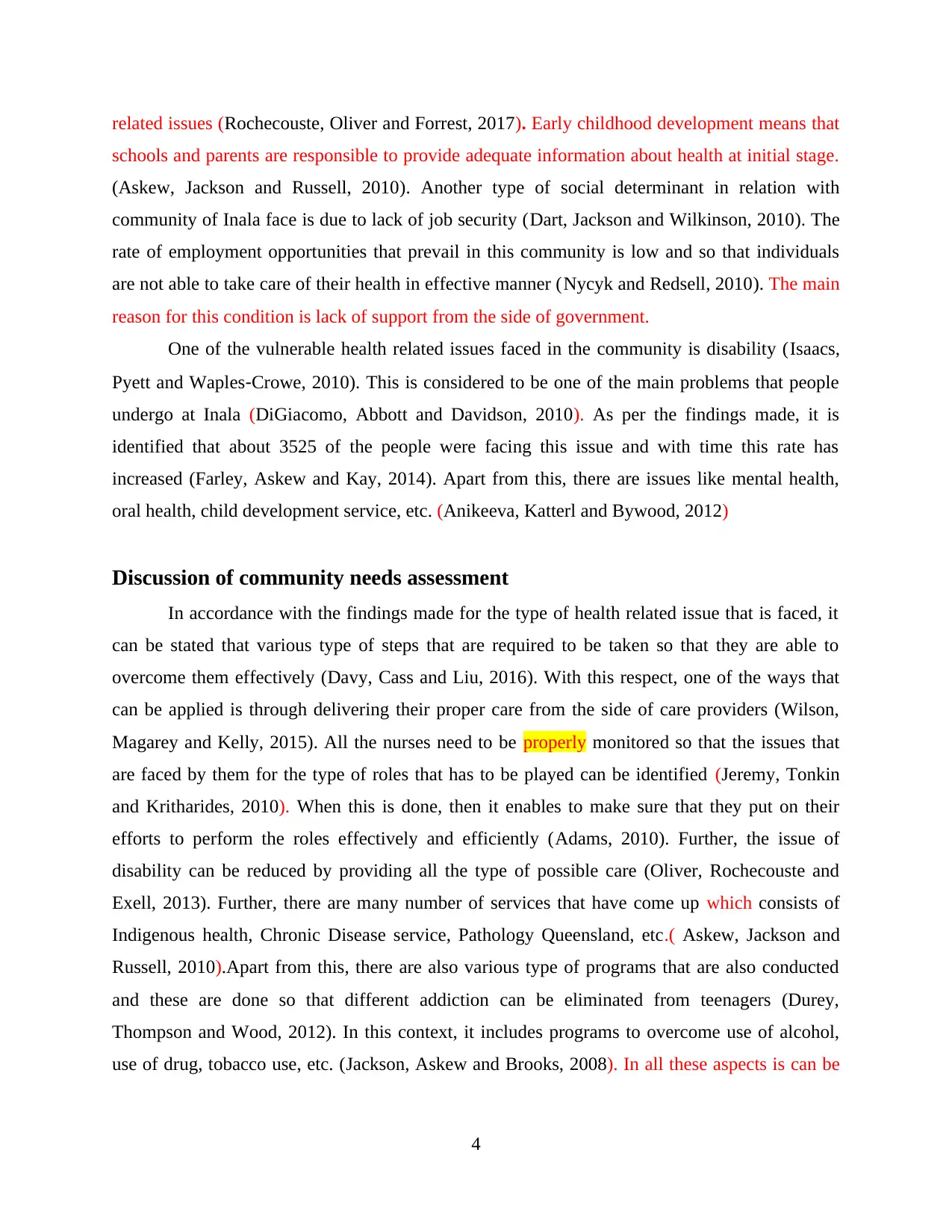
related issues (Rochecouste, Oliver and Forrest, 2017). Early childhood development means that
schools and parents are responsible to provide adequate information about health at initial stage.
(Askew, Jackson and Russell, 2010). Another type of social determinant in relation with
community of Inala face is due to lack of job security (Dart, Jackson and Wilkinson, 2010). The
rate of employment opportunities that prevail in this community is low and so that individuals
are not able to take care of their health in effective manner (Nycyk and Redsell, 2010). The main
reason for this condition is lack of support from the side of government.
One of the vulnerable health related issues faced in the community is disability (Isaacs,
Pyett and Waples‐Crowe, 2010). This is considered to be one of the main problems that people
undergo at Inala (DiGiacomo, Abbott and Davidson, 2010). As per the findings made, it is
identified that about 3525 of the people were facing this issue and with time this rate has
increased (Farley, Askew and Kay, 2014). Apart from this, there are issues like mental health,
oral health, child development service, etc. (Anikeeva, Katterl and Bywood, 2012)
Discussion of community needs assessment
In accordance with the findings made for the type of health related issue that is faced, it
can be stated that various type of steps that are required to be taken so that they are able to
overcome them effectively (Davy, Cass and Liu, 2016). With this respect, one of the ways that
can be applied is through delivering their proper care from the side of care providers (Wilson,
Magarey and Kelly, 2015). All the nurses need to be properly monitored so that the issues that
are faced by them for the type of roles that has to be played can be identified (Jeremy, Tonkin
and Kritharides, 2010). When this is done, then it enables to make sure that they put on their
efforts to perform the roles effectively and efficiently (Adams, 2010). Further, the issue of
disability can be reduced by providing all the type of possible care (Oliver, Rochecouste and
Exell, 2013). Further, there are many number of services that have come up which consists of
Indigenous health, Chronic Disease service, Pathology Queensland, etc.( Askew, Jackson and
Russell, 2010).Apart from this, there are also various type of programs that are also conducted
and these are done so that different addiction can be eliminated from teenagers (Durey,
Thompson and Wood, 2012). In this context, it includes programs to overcome use of alcohol,
use of drug, tobacco use, etc. (Jackson, Askew and Brooks, 2008). In all these aspects is can be
4
schools and parents are responsible to provide adequate information about health at initial stage.
(Askew, Jackson and Russell, 2010). Another type of social determinant in relation with
community of Inala face is due to lack of job security (Dart, Jackson and Wilkinson, 2010). The
rate of employment opportunities that prevail in this community is low and so that individuals
are not able to take care of their health in effective manner (Nycyk and Redsell, 2010). The main
reason for this condition is lack of support from the side of government.
One of the vulnerable health related issues faced in the community is disability (Isaacs,
Pyett and Waples‐Crowe, 2010). This is considered to be one of the main problems that people
undergo at Inala (DiGiacomo, Abbott and Davidson, 2010). As per the findings made, it is
identified that about 3525 of the people were facing this issue and with time this rate has
increased (Farley, Askew and Kay, 2014). Apart from this, there are issues like mental health,
oral health, child development service, etc. (Anikeeva, Katterl and Bywood, 2012)
Discussion of community needs assessment
In accordance with the findings made for the type of health related issue that is faced, it
can be stated that various type of steps that are required to be taken so that they are able to
overcome them effectively (Davy, Cass and Liu, 2016). With this respect, one of the ways that
can be applied is through delivering their proper care from the side of care providers (Wilson,
Magarey and Kelly, 2015). All the nurses need to be properly monitored so that the issues that
are faced by them for the type of roles that has to be played can be identified (Jeremy, Tonkin
and Kritharides, 2010). When this is done, then it enables to make sure that they put on their
efforts to perform the roles effectively and efficiently (Adams, 2010). Further, the issue of
disability can be reduced by providing all the type of possible care (Oliver, Rochecouste and
Exell, 2013). Further, there are many number of services that have come up which consists of
Indigenous health, Chronic Disease service, Pathology Queensland, etc.( Askew, Jackson and
Russell, 2010).Apart from this, there are also various type of programs that are also conducted
and these are done so that different addiction can be eliminated from teenagers (Durey,
Thompson and Wood, 2012). In this context, it includes programs to overcome use of alcohol,
use of drug, tobacco use, etc. (Jackson, Askew and Brooks, 2008). In all these aspects is can be
4
⊘ This is a preview!⊘
Do you want full access?
Subscribe today to unlock all pages.

Trusted by 1+ million students worldwide
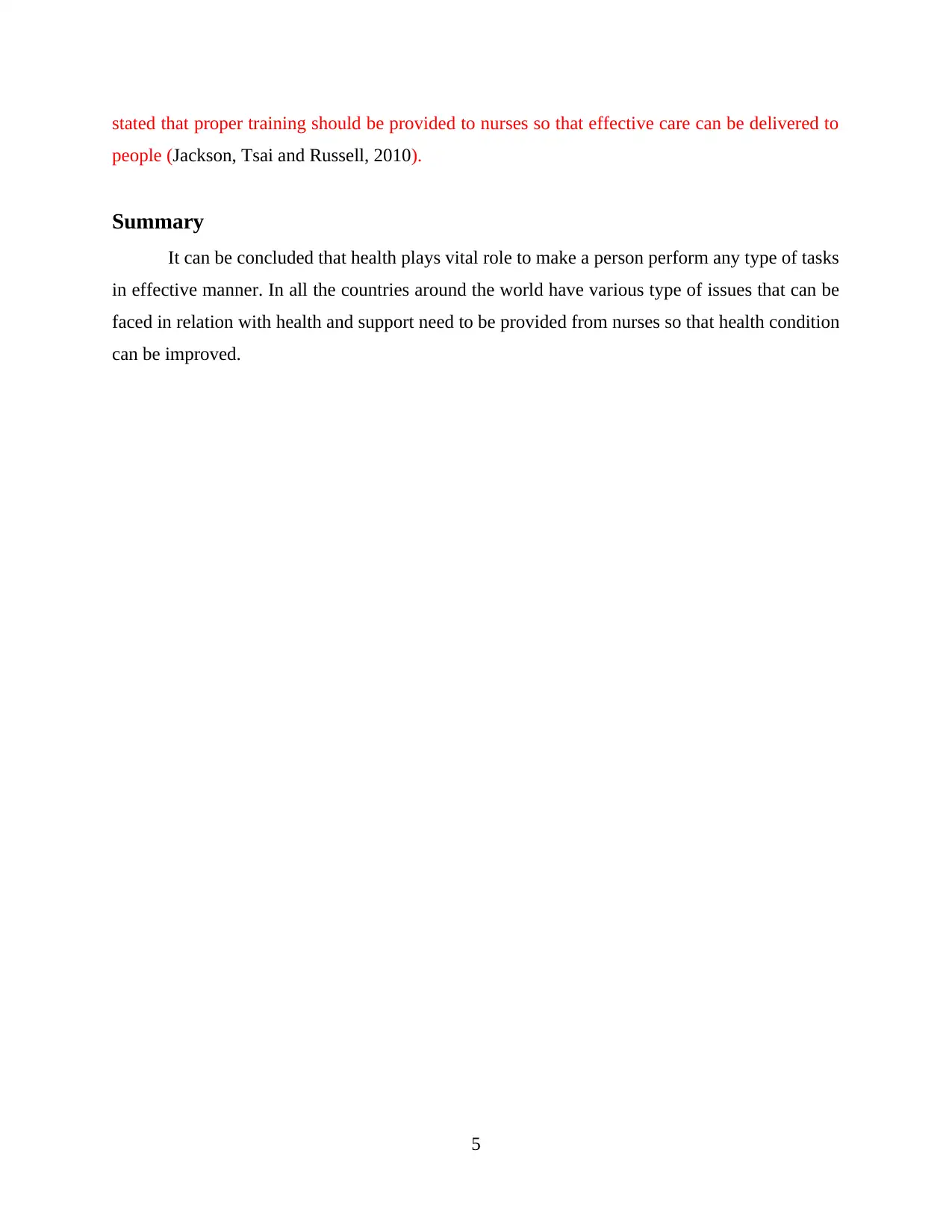
stated that proper training should be provided to nurses so that effective care can be delivered to
people (Jackson, Tsai and Russell, 2010).
Summary
It can be concluded that health plays vital role to make a person perform any type of tasks
in effective manner. In all the countries around the world have various type of issues that can be
faced in relation with health and support need to be provided from nurses so that health condition
can be improved.
5
people (Jackson, Tsai and Russell, 2010).
Summary
It can be concluded that health plays vital role to make a person perform any type of tasks
in effective manner. In all the countries around the world have various type of issues that can be
faced in relation with health and support need to be provided from nurses so that health condition
can be improved.
5
Paraphrase This Document
Need a fresh take? Get an instant paraphrase of this document with our AI Paraphraser
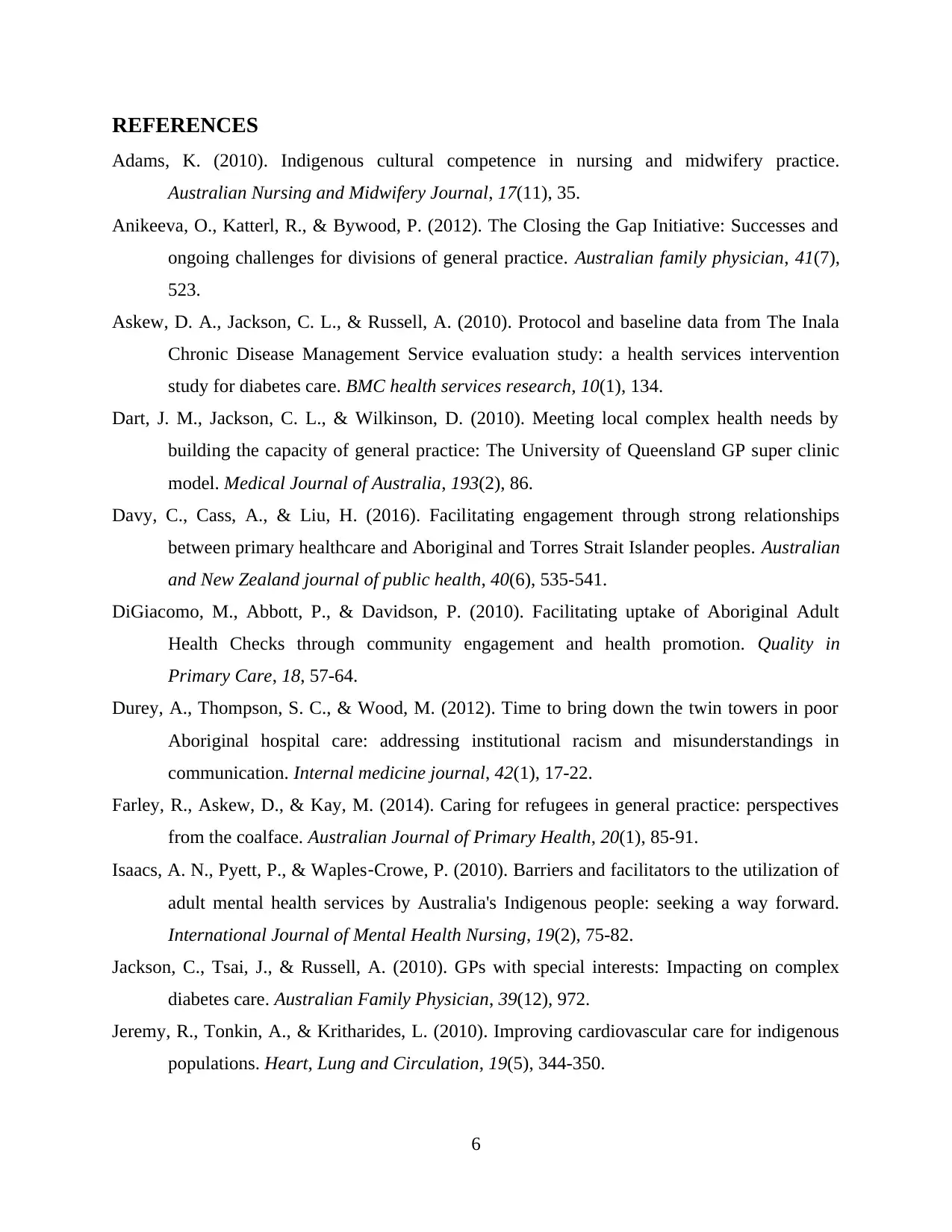
REFERENCES
Adams, K. (2010). Indigenous cultural competence in nursing and midwifery practice.
Australian Nursing and Midwifery Journal, 17(11), 35.
Anikeeva, O., Katterl, R., & Bywood, P. (2012). The Closing the Gap Initiative: Successes and
ongoing challenges for divisions of general practice. Australian family physician, 41(7),
523.
Askew, D. A., Jackson, C. L., & Russell, A. (2010). Protocol and baseline data from The Inala
Chronic Disease Management Service evaluation study: a health services intervention
study for diabetes care. BMC health services research, 10(1), 134.
Dart, J. M., Jackson, C. L., & Wilkinson, D. (2010). Meeting local complex health needs by
building the capacity of general practice: The University of Queensland GP super clinic
model. Medical Journal of Australia, 193(2), 86.
Davy, C., Cass, A., & Liu, H. (2016). Facilitating engagement through strong relationships
between primary healthcare and Aboriginal and Torres Strait Islander peoples. Australian
and New Zealand journal of public health, 40(6), 535-541.
DiGiacomo, M., Abbott, P., & Davidson, P. (2010). Facilitating uptake of Aboriginal Adult
Health Checks through community engagement and health promotion. Quality in
Primary Care, 18, 57-64.
Durey, A., Thompson, S. C., & Wood, M. (2012). Time to bring down the twin towers in poor
Aboriginal hospital care: addressing institutional racism and misunderstandings in
communication. Internal medicine journal, 42(1), 17-22.
Farley, R., Askew, D., & Kay, M. (2014). Caring for refugees in general practice: perspectives
from the coalface. Australian Journal of Primary Health, 20(1), 85-91.
Isaacs, A. N., Pyett, P., & Waples‐Crowe, P. (2010). Barriers and facilitators to the utilization of
adult mental health services by Australia's Indigenous people: seeking a way forward.
International Journal of Mental Health Nursing, 19(2), 75-82.
Jackson, C., Tsai, J., & Russell, A. (2010). GPs with special interests: Impacting on complex
diabetes care. Australian Family Physician, 39(12), 972.
Jeremy, R., Tonkin, A., & Kritharides, L. (2010). Improving cardiovascular care for indigenous
populations. Heart, Lung and Circulation, 19(5), 344-350.
6
Adams, K. (2010). Indigenous cultural competence in nursing and midwifery practice.
Australian Nursing and Midwifery Journal, 17(11), 35.
Anikeeva, O., Katterl, R., & Bywood, P. (2012). The Closing the Gap Initiative: Successes and
ongoing challenges for divisions of general practice. Australian family physician, 41(7),
523.
Askew, D. A., Jackson, C. L., & Russell, A. (2010). Protocol and baseline data from The Inala
Chronic Disease Management Service evaluation study: a health services intervention
study for diabetes care. BMC health services research, 10(1), 134.
Dart, J. M., Jackson, C. L., & Wilkinson, D. (2010). Meeting local complex health needs by
building the capacity of general practice: The University of Queensland GP super clinic
model. Medical Journal of Australia, 193(2), 86.
Davy, C., Cass, A., & Liu, H. (2016). Facilitating engagement through strong relationships
between primary healthcare and Aboriginal and Torres Strait Islander peoples. Australian
and New Zealand journal of public health, 40(6), 535-541.
DiGiacomo, M., Abbott, P., & Davidson, P. (2010). Facilitating uptake of Aboriginal Adult
Health Checks through community engagement and health promotion. Quality in
Primary Care, 18, 57-64.
Durey, A., Thompson, S. C., & Wood, M. (2012). Time to bring down the twin towers in poor
Aboriginal hospital care: addressing institutional racism and misunderstandings in
communication. Internal medicine journal, 42(1), 17-22.
Farley, R., Askew, D., & Kay, M. (2014). Caring for refugees in general practice: perspectives
from the coalface. Australian Journal of Primary Health, 20(1), 85-91.
Isaacs, A. N., Pyett, P., & Waples‐Crowe, P. (2010). Barriers and facilitators to the utilization of
adult mental health services by Australia's Indigenous people: seeking a way forward.
International Journal of Mental Health Nursing, 19(2), 75-82.
Jackson, C., Tsai, J., & Russell, A. (2010). GPs with special interests: Impacting on complex
diabetes care. Australian Family Physician, 39(12), 972.
Jeremy, R., Tonkin, A., & Kritharides, L. (2010). Improving cardiovascular care for indigenous
populations. Heart, Lung and Circulation, 19(5), 344-350.
6
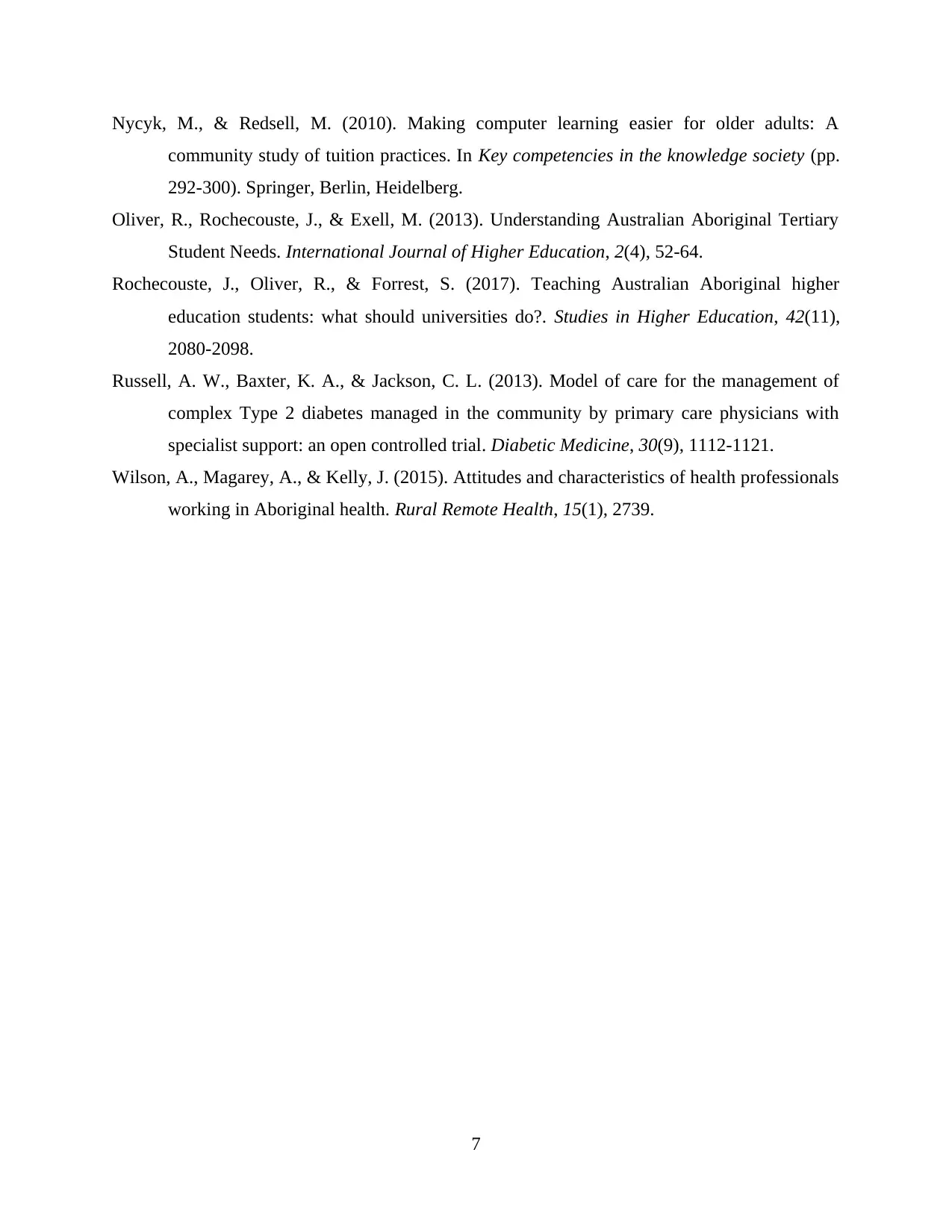
Nycyk, M., & Redsell, M. (2010). Making computer learning easier for older adults: A
community study of tuition practices. In Key competencies in the knowledge society (pp.
292-300). Springer, Berlin, Heidelberg.
Oliver, R., Rochecouste, J., & Exell, M. (2013). Understanding Australian Aboriginal Tertiary
Student Needs. International Journal of Higher Education, 2(4), 52-64.
Rochecouste, J., Oliver, R., & Forrest, S. (2017). Teaching Australian Aboriginal higher
education students: what should universities do?. Studies in Higher Education, 42(11),
2080-2098.
Russell, A. W., Baxter, K. A., & Jackson, C. L. (2013). Model of care for the management of
complex Type 2 diabetes managed in the community by primary care physicians with
specialist support: an open controlled trial. Diabetic Medicine, 30(9), 1112-1121.
Wilson, A., Magarey, A., & Kelly, J. (2015). Attitudes and characteristics of health professionals
working in Aboriginal health. Rural Remote Health, 15(1), 2739.
7
community study of tuition practices. In Key competencies in the knowledge society (pp.
292-300). Springer, Berlin, Heidelberg.
Oliver, R., Rochecouste, J., & Exell, M. (2013). Understanding Australian Aboriginal Tertiary
Student Needs. International Journal of Higher Education, 2(4), 52-64.
Rochecouste, J., Oliver, R., & Forrest, S. (2017). Teaching Australian Aboriginal higher
education students: what should universities do?. Studies in Higher Education, 42(11),
2080-2098.
Russell, A. W., Baxter, K. A., & Jackson, C. L. (2013). Model of care for the management of
complex Type 2 diabetes managed in the community by primary care physicians with
specialist support: an open controlled trial. Diabetic Medicine, 30(9), 1112-1121.
Wilson, A., Magarey, A., & Kelly, J. (2015). Attitudes and characteristics of health professionals
working in Aboriginal health. Rural Remote Health, 15(1), 2739.
7
⊘ This is a preview!⊘
Do you want full access?
Subscribe today to unlock all pages.

Trusted by 1+ million students worldwide
1 out of 9
Related Documents
Your All-in-One AI-Powered Toolkit for Academic Success.
+13062052269
info@desklib.com
Available 24*7 on WhatsApp / Email
![[object Object]](/_next/static/media/star-bottom.7253800d.svg)
Unlock your academic potential
Copyright © 2020–2025 A2Z Services. All Rights Reserved. Developed and managed by ZUCOL.





